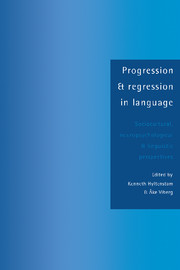 Progression and Regression in Language
Progression and Regression in Language Book contents
- Frontmatter
- Contents
- List of contributors
- Preface
- INTRODUCTION
- THE SOCIOCULTURAL SETTING
- PSYCHO- AND NEUROLINGUISTIC ASPECTS
- THE LINGUISTIC PERSPECTIVE 1: DISCOURSE, GRAMMAR, AND LEXIS
- 10 Crosslinguistic perspectives on native language acquisition
- 11 Syntactic development in Danish L2
- 12 The weaker language in bilingual Swedish-French children
- 13 Four operating principles and input distribution as explanations for underdeveloped and mature morphological systems
- 14 Crosslinguistic perspectives on lexical organization and lexical progression
- 15 Attrition or expansion? Changes in the lexicon of Finnish and American adult bilinguals in Sweden
- THE LINGUISTIC PERSPECTIVE 2: PHONOLOGY
- Index
10 - Crosslinguistic perspectives on native language acquisition
Published online by Cambridge University Press: 06 July 2010
- Frontmatter
- Contents
- List of contributors
- Preface
- INTRODUCTION
- THE SOCIOCULTURAL SETTING
- PSYCHO- AND NEUROLINGUISTIC ASPECTS
- THE LINGUISTIC PERSPECTIVE 1: DISCOURSE, GRAMMAR, AND LEXIS
- 10 Crosslinguistic perspectives on native language acquisition
- 11 Syntactic development in Danish L2
- 12 The weaker language in bilingual Swedish-French children
- 13 Four operating principles and input distribution as explanations for underdeveloped and mature morphological systems
- 14 Crosslinguistic perspectives on lexical organization and lexical progression
- 15 Attrition or expansion? Changes in the lexicon of Finnish and American adult bilinguals in Sweden
- THE LINGUISTIC PERSPECTIVE 2: PHONOLOGY
- Index
Summary
Current crosslinguistic acquisition research reflects varied motivations. Three of these are analyzed as background to a developmental perspective on acquisition across and within languages. Each of the three orientations discussed below has a rather different focus: on mechanisms of acquisition, on endstate grammars, and on linguistic functions and the development of discourse respectively. These concerns are clearly not mutually exclusive, either in principle or practice, but it proves useful to distinguish between them for purposes of exposition.
MECHANISMS AND PRINCIPLES GUIDING ACQUISITION: A CONFLUENCE OF CUES
One major thrust in current research is concerned with psycholinguistic factors underlying the process of acquisition, what have been called ‘mechanisms of language acquisition’ (MacWhinney, 1987). Such mechanisms include ‘the competition model’ (Bates and MacWhinney, 1987; MacWhinney, 1989); a concern with various kinds of ‘bootstrapping’ (Naigles, Gleitman and Gleitman, in press; Pinker, 1984, 1987; Shatz, 1986); as well as extensions of earlier work on acquisitional strategies and principles for relating forms to meanings, such as Eve Clark's (1987, 1988) ‘principle of contrast’ and, most particularly, Slobin's (1973, 1985b) ‘operating principles’. Researchers differ in how committed they are to nativism – i.e. the weight they assign to innate principles and categories compared with the importance of environmental factors such as input, on the one hand, and learner-internal ‘constructivist’ factors, on the other. They also differ in their commitment to modularity – i.e. the extent to which they view language – particularly the syntactic component – as a self-contained or encapsulated domain of knowledge or as bound up with other cognitive domains.
- Type
- Chapter
- Information
- Progression and Regression in LanguageSociocultural, Neuropsychological and Linguistic Perspectives, pp. 245 - 266Publisher: Cambridge University PressPrint publication year: 1994
